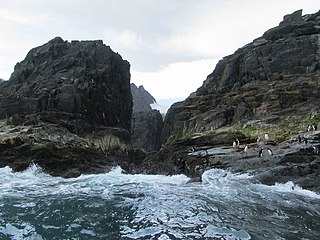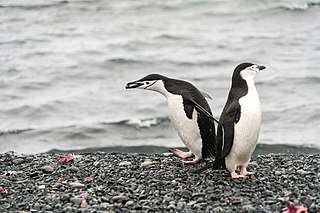Related Research Articles

Coronation Island is the largest of the South Orkney Islands, 25 nautical miles (46 km) long and from 3 to 8 nautical miles wide. The island extends in a general east–west direction, is mainly ice-covered and comprises numerous bays, glaciers and peaks, the highest rising to 1,265 metres (4,150 ft).

Rowett Island is a rocky island 0.5 miles (0.8 km) long, lying immediately off Cape Lookout, Elephant Island, in the South Shetland Islands. Rowett Island is located at 61°17′S55°13′W. Rowett Island was known to both American and British sealers as early as 1822. Rowett Island was named by members of a British expedition (1921-1922) under Ernest Shackleton for John Quiller Rowett, chief patron of the expedition.

Hughes Bay is a bay lying between Cape Sterneck and Cape Murray along the west coast of the Antarctic Peninsula. It is 42 kilometres (26 mi) wide and lies south of Chavdar Peninsula and north of Pefaur (Ventimiglia) Peninsula, indenting the Danco Coast on the west side of Graham Land for 20 kilometres (12 mi).

Cape Hooker is the south-eastern point of Low Island, in the South Shetland Islands of Antarctica. The feature was roughly charted by nineteenth century sealers; it was further charted by Commander Henry Foster in 1829 but shown as the north-eastern point of the island. Following air photography by the Falkland Islands and Dependencies Aerial Survey Expedition in 1956, the charted shape of the island was drastically altered and the name Cape Hooker was applied to its south-eastern point as originally described.

McFarlane Strait is a strait lying between Greenwich Island and Livingston Island, in the South Shetland Islands off Antarctica. It is 24 kilometres (13 nmi) long and 3 kilometres (1.6 nmi) wide. The name appears on an 1822 chart by Captain George Powell, a British sealer, and is now well established in international usage.

Morton Strait is the 9 km (4.9 nmi)-long and 6.2 km (3.3 nmi)-wide strait between Snow Island on the southwest and Rugged Island and Livingston Island on the northeast, in the South Shetland Islands, Antarctica. The Aim Rocks and Long Rock lie in the strait.

Devils Point is a point marking the southwest extremity of Byers Peninsula, Livingston Island in the South Shetland Islands, Antarctica and forming the southeast side of the entrance to Osogovo Bay and the west side of the entrance to Raskuporis Cove. The point is separated from Vardim Rocks to the south by Hell Gates. Lucifer Crags, a rocky bluff rising to 81 m at the south extremity of President Beaches, surmount Devils Point on the southwest, Acheron Lake on the northeast and Siren Lake on the east-southeast. The area was visited by early 19th century sealers.

Borceguí Island is an ice-free island in the South Shetland Islands, midway between Cape Yelcho and the Gibbous Rocks, 2 kilometres (1 nmi) off the north coast of Elephant Island. The name was applied by the command of the Argentine sea-going tug Chiriguano in the 1954–55 cruise; in Spanish "borceguí" means half-boot and describes the shape of the island.
Demay Point is a headland which forms the west side of the entrance to Admiralty Bay, King George Island, in the South Shetland Islands. This point was known to sealers as early as 1822. It was named almost 100 years later by the French Antarctic Expedition, 1908–10, under Jean-Baptiste Charcot. It has a Polish refuge, but it is unclear whether the refuge is being used at all
Furse Peninsula is the eastern part of Gibbs Island, east of The Spit, in the South Shetland Islands. The name "Narrow Island" was used by Captain George Powell in 1822, with reference to the entire island; in subsequent use the reference was occasionally limited to this peninsula. It was named in 1980 by the UK Antarctic Place-Names Committee after Commander John R. (Chris) Furse, Royal Navy, leader of the Joint Services Expedition to the Elephant Island Group, 1976–77.

The Eden Rocks are two rocks lying 1.5 km off the east coast of Dundee Island, at the northern end of the Antarctic Peninsula. A small island was reported there on 30 December 1842 by Captain James Clark Ross of the Royal Navy, who named it "Eden Island" for Captain Charles Eden. Following a survey by the Falkland Islands Dependencies Survey in 1953, it was reported that the feature consists of two rocky islets rising to about 90 m in height and lying close together.

Mount Elder is a 940-metre (3,080 ft) mountain lying between Endurance Glacier and Mount Pendragon on Elephant Island, in the South Shetland Islands of Antarctica. It was named by the UK Antarctic Place-Names Committee for Captain John P. Elder, Royal Engineers, surveyor of the U.K. Joint Services Expedition to Elephant Island in 1970–71.

Fildes Strait is a strait which extends in a general east-west direction between King George Island and Nelson Island, in the South Shetland Islands. This strait has been known to sealers in the area since about 1822, but at that time it appeared on the charts as "Field's Strait". It was probably named for Robert Fildes, a British sealer of that period, whose vessel Robert was wrecked in Clothier Harbour in 1822.
Foul Point on Yordanov Island lies at the east side of the entrance to Ommanney Bay on the north side of Coronation Island, in the South Orkney Islands. It was discovered in December 1821 in the course of the joint cruise by Captain George Powell, British sealer, and Captain Nathaniel Palmer, American sealer. The name first appears on Powell's chart, published in 1822. It is basically an area of coastal ice-free terrain with large seabird colonies and lichen-dominated cliffs, and permanent ice rising to the Brisbane Heights plateau which provides an excellent representative area of a pristine ice environment near the northern limit of the maritime Antarctic
Hammerstad Reef is a reef 1.5 nautical miles (3 km) south of Cape Rosa, lying in the northern part of the entrance to Queen Maud Bay off the south coast of South Georgia. It was surveyed by the South Georgia Survey in the period 1951–57, and named by the UK Antarctic Place-Names Committee for Thorleif Hammerstad, a sealer of the Compañía Argentina de Pesca, Grytviken, for several years beginning in 1946.
Minstrel Point is a point about midway between Cape Lindsey and Cape Yelcho on the west coast of Elephant Island, in the South Shetland Islands off Antarctica. It was named by the UK Joint Services Expedition to Elephant Island of 1970–71, after the brig Minstrel, a sealer from London, which anchored north of this feature in February 1821.
Cape Hartree is a cape which forms the southwestern tip of Mossman Peninsula on the south coast of Laurie Island, in the South Orkney Islands. To the west of Cape Hartree lie Buchan Bay and Cape Murdoch.
Hauge Reef is a chain of islands and rocks extending in an east-northeast direction from the eastern extremity of Annenkov Island to a point about 3 nautical miles (6 km) west-southwest of Cape Darnley, South Georgia. It was first charted in 1819 by a Russian expedition under Fabian Gottlieb von Bellingshausen. The reef was surveyed by the South Georgia Survey (SGS), 1951–52, and named for Captain Ole Hauge, of the sealer Albatros, whose knowledge of the coasts of South Georgia was of great assistance to the SGS.

Cape Valentine is a cape on the northeast side of Gurkovska Cove forming the northeast extremity of Elephant Island in the South Shetland Islands of Antarctica. The name was in use by American and British sealers as early as 1822 and is now well established.
Rodman Cove is a cove south of Cape Lindsey on the west coast of Elephant Island, in the South Shetland Islands of Antarctica. It was named for Benjamin Rodman of New Bedford, Massachusetts, owner of whaling ships operating from that port in the 1820s and 1830s. The name was suggested by American geographer Lawrence Martin and has appeared in descriptions and charts of Elephant Island since about 1943.
References
- ↑ "Cape Lindsey". Geographic Names Information System . United States Geological Survey, United States Department of the Interior . Retrieved 17 June 2013.
- ↑ "West Reef". Geographic Names Information System . United States Geological Survey, United States Department of the Interior . Retrieved 17 June 2013.
- ↑ "Cruiser Rocks". Geographic Names Information System . United States Geological Survey, United States Department of the Interior . Retrieved 7 December 2011.
![]() This article incorporates public domain material from websites or documents of the United States Geological Survey .
This article incorporates public domain material from websites or documents of the United States Geological Survey .
61°6′S55°29′W / 61.100°S 55.483°W